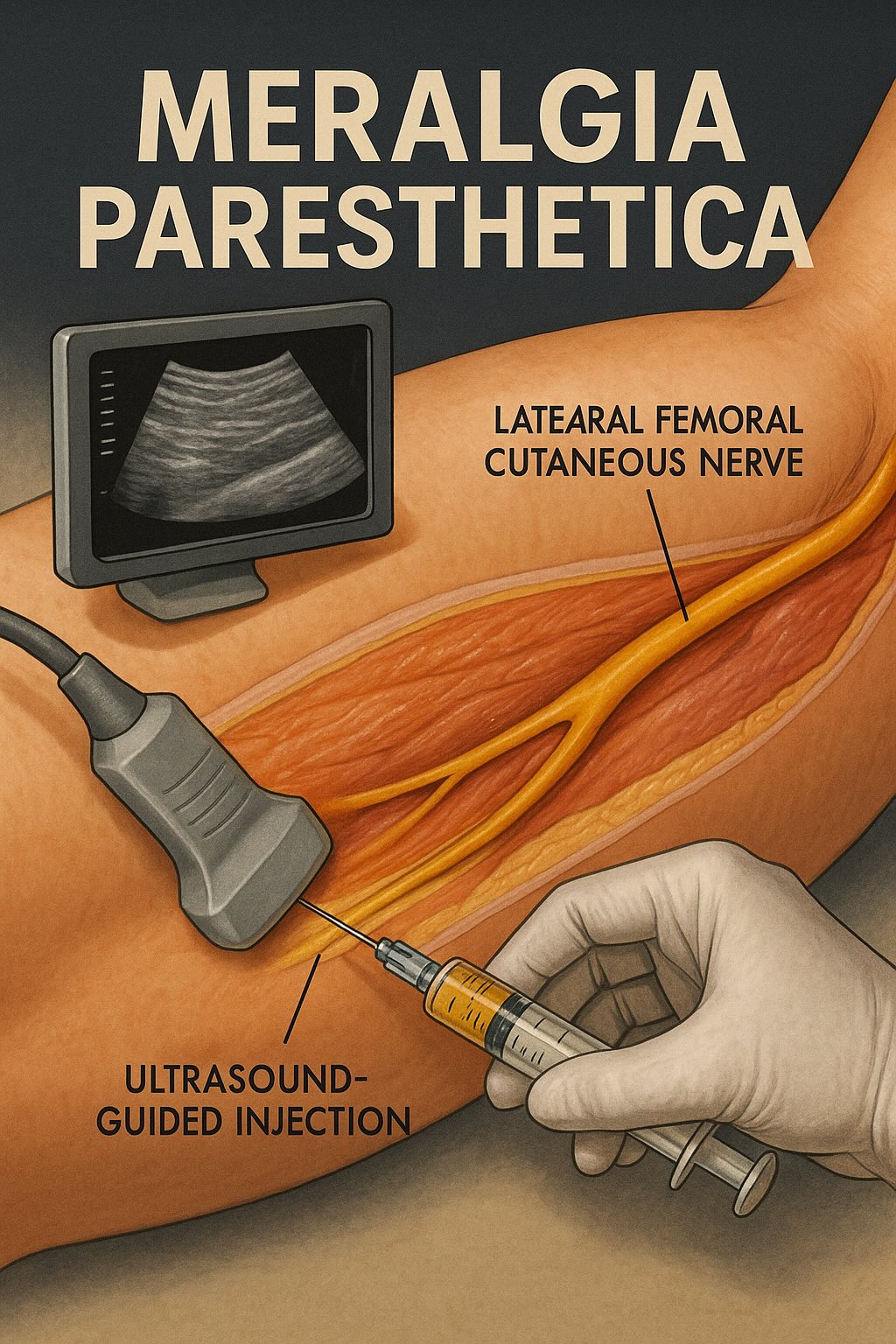Email : admin@mskdoc.co.nz | Phone : 02727 00100
Opening Hours : Mon-Friday : 10 AM – 4 PM
Email : admin@mskdoc.co.nz | Phone : 02727 00100
Opening Hours : Mon-Friday : 10 AM – 4 PM
Email : admin@mskdoc.co.nz | Phone : 02727 00100 | Opening Hours : Mon-Friday : 10 AM – 4 PM
By: Dr Zaid Matti
Musculoskeletal Medicine Specialist
Meralgia paresthetica—commonly called lateral femoral cutaneous nerve entrapment—causes burning, tingling, or numbness along the outer thigh. While many patients improve with simple lifestyle changes, some may benefit from targeted, regenerative treatments like platelet-rich plasma (PRP).

What Is Meralgia Paresthetica?
Meralgia paresthetica occurs when the lateral femoral cutaneous nerve (LFCN) is compressed as it passes beneath the inguinal ligament near the anterior superior iliac spine. Because the LFCN is purely sensory, patients experience only altered sensation—no muscle weakness.
Key Risk Factors
– Tight belts, corsets or clothing
– Obesity or rapid weight gain
– Pregnancy
– Diabetes mellitus
– Hip or pelvic surgery
How It Presents & How It’s Diagnosed
Common Symptoms
– Burning or tingling on the outer thigh
– Numbness or hypersensitivity to light touch
– Symptoms worsen with standing, walking or hip extension
Diagnostic Clues
– Positive Tinel’s sign over the inguinal ligament
– Ultrasound-guided diagnostic block with local anesthetic
Conventional Treatment Options
Lifestyle Modification
– Wear looser clothing, avoid tight belts
– Weight loss if appropriate
– Activity or posture changes
Medications
– Gabapentin or pregabalin
– Tricyclic antidepressants
– Topical lidocaine or capsaicin
Ultrasound-Guided Nerve Block & Hydrodissection
– Inject local anesthetic ± corticosteroid around the LFCN to separate adhesions and reduce inflammation
Surgical Options (for refractory cases)
– Neurolysis (decompression)
– Neurectomy (surgical removal of the nerve segment)
PRP: A Regenerative Frontier in Nerve healing
What Is PRP?
Platelet-rich plasma is an autologous blood derivative concentrated in platelets and growth factors (PDGF, VEGF, NGF, TGF-β) that promote tissue regeneration, angiogenesis, and modulate inflammation.
Why Consider PRP for Meralgia Paresthetica?
– Stimulates Schwann cell activation and myelin regeneration
– Improves microvascular perfusion via angiogenesis
– Downregulates pro-inflammatory cytokines involved in chronic neuropathic pain
Technique: Ultrasound-Guided PRP Hydrodissection
PRP Preparation: draw 30–60 mL of blood; double-spin to obtain 5–10 mL of leukocyte-poor PRP
Imaging: position patient supine with slight hip flexion; use high-frequency ultrasound to locate the LFCN beneath the inguinal ligament
Injection: advance a 25–27 G needle under ultrasound guidance; inject PRP around the nerve to separate adhesions and deliver growth factors
Aftercare: brief rest followed by gentle hip mobility exercises and physical therapy
Evidence Summary
– Case reports describe successful PRP hydrodissection of the LFCN with significant symptom relief
– Animal models demonstrate accelerated axonal growth and increased myelin thickness with PRP application
– Systematic reviews highlight PRP’s safety profile and call for controlled trials in entrapment neuropathies
Advantages & Considerations
Advantages
– Autologous and low risk of allergy
– Minimally invasive outpatient procedure
– Combines mechanical hydrodissection with regenerative biology
Considerations
– Variability in PRP formulations (platelet concentration, leukocyte content)
– Cost and insurance coverage may vary
– Need for high-quality, long-term clinical trials
Future Directions
– Standardize PRP preparation protocols (platelet counts, leukocyte levels)
– Conduct comparative trials versus corticosteroids or dextrose prolotherapy
– Evaluate long-term outcomes through imaging and electrophysiology
Take-Home Messages
– Meralgia paresthetica is a sensory neuropathy caused by compression of the LFCN, leading to outer-thigh burning, tingling, or numbness
– Most cases improve with lifestyle changes, medications, and nerve blocks
– PRP hydrodissection offers a novel regenerative approach for refractory cases
– Rigorous clinical trials are needed before PRP becomes a standard treatment